Ocular surface reconstruction: The use of oral mucosal epithelial cells
It is important to properly handle the human amniotic membrane with the cultured epithelial cells.
 Thomas John |
The ocular surface includes the conjunctiva and the cornea, with its outer limits being the upper and lower eyelids.
Unlike the surface of the body’s skin coverage, the ocular surface is constantly bathed by the tear film and cleansed by the blinking action of the eyelids. It usually forms a protective barrier against microorganisms to the interior of the eye and contributes to the quality of vision.
When this surface of the eye is compromised and medical management is a failure, surgical intervention may become a necessity that is often challenging, even to the corneal surgeon. Ocular surface disease includes limbal stem cell deficiency and squamous metaplasia in which keratinization shifts the once normal ocular surface to the abnormal skin-like surface with often significant deleterious effects on the eye and vision.
Ocular surface disease may be classified clinically into two major categories: diseases with a conjunctivalized cornea with a viable tear film and a wet ocular surface, and a second category in which the ocular surface is completely dry and keratinized. In the former category, a series of surgical procedures, collectively called ocular surface reconstruction, may be applicable, whereas in the second category, only keratoprosthesis may be a possibility.
In this column, Dr. Solomon addresses ocular surface reconstruction and describes some of the surgical techniques that may be useful for the corneal surgeon when confronted with a compromised ocular surface that has failed all medical management; namely, the use of oral mucosal epithelial cells in the surgical management of ocular surface disease. Currently, however, there are no U.S. Food and Drug Administration-approved, commercially available ex vivo cultured epithelial cells that can be used for ocular surface reconstruction.
– Thomas John, MD
OSN Corneal Dissection
Editor
Anesthesia
General anesthesia is preferred for extensive ocular surface reconstruction.
 Abraham Solomon |
Ex vivo culture system
The surgical approach includes an ex vivo culture system in which the limbal or the oral mucosal epithelial cells (Figure 1) are biopsy harvested and prepared either as an explant culture or as suspension of single cells that are separated and then seeded on the carrier. Additional steps may include air lifting to promote stratification of cells.
It is important to use a proper culture medium and preparation of the carrier for the cells in a special culture insert that can be easily handled and transferred to the operating room (Figure 2) at the time of ocular surface reconstruction. A popular and convenient carrier for these ex vivo cultured epithelial cells is the human amniotic membrane.
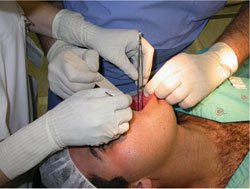 Figure 1. Harvesting oral biopsy for oral epithelial transplantation onto the ocular surface after ex vivo culture system. |
 Figure 2. Culture inserts of the amniotic membrane with the cultured oral epithelial cells. Images: Solomon A |
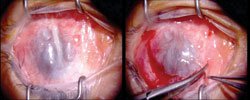 Figure 3. Intraoperative photograph shows extensive ocular surface disease with complete obliteration of the normal corneal surface (left); Initial surgical steps in the removal of the corneal fibrovascular tissue (right). |
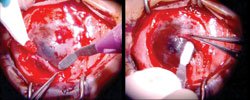 Figure 4. Superficial keratectomy reveals the underlying cornea beneath the surface fibrovascular tissues. |
A more recent alternative carrier to the human amniotic membrane is a temperature sensitive polymer membrane. The epithelial cells readily adhere to and proliferate on the polymer membrane in normal culture conditions at 37°C. At room temperature, the epithelial sheet detaches from the polymer and is then transferred and applied over the ocular surface.
Recipient corneal surgery
The surgical technique of cultured cell transplantation includes the usual removal of corneal fibrovascular tissue (Figure 3), superficial keratectomy (Figure 4) and removal of subconjunctival tissue 360°, up to 5 mm to 7 mm from the limbus (Figure 5). This may be followed by application of mitomycin C 0.02% for 2 minutes (Figure 6).
The ocular surface is then profusely irrigated with sterile balanced salt solution. After the cornea and the perilimbal sclera are clean and exposed, the human amniotic membrane with the cultured epithelial cells are removed from the culture insert, spread over the ocular surface (Figure 7) and sutured to the sclera with continuous and interrupted 10-0 nylon sutures (Figure 8).
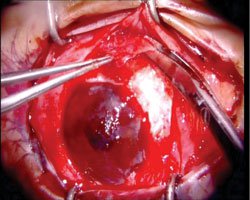 Figure 5. Removal of subconjunctival tissue 360°, up to 5 mm to 7 mm distal to the limbus on the scleral side. |
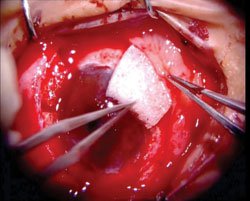 Figure 6. Intraoperative photograph shows the application of mitomycin C 0.02% for 2 minutes, followed by copious irrigation with sterile balanced salt solution. |
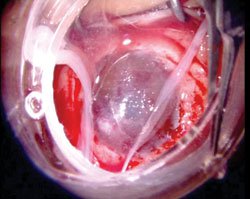 Figure 7. After the cornea and the perilimbal sclera are clean and exposed, the human amniotic membrane with the cultured epithelial cells are removed from the culture insert, and it is spread over the recipient ocular surface. |
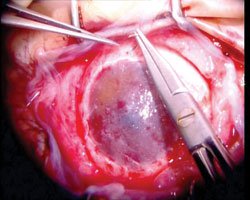 Figure 8. The human amniotic membrane with the cultured epithelial cells is spread over the recipient ocular surface and sutured to the sclera with continuous and interrupted 10-0 nylon sutures. |
A temporary tarsorrhaphy is performed at the end of the procedure and kept for at least 2 weeks to protect the transplanted epithelial cells and to ensure proper integration of the cultured epithelial cells and the amniotic membrane on the ocular surface. The sutures are removed after 2 weeks when full ocular surface epithelialization is noted.
Surgical pearls and tips
- Use the proper plane of dissection during the excision of the fibrovascular tissue.
- Care should be taken when handling the human amniotic membrane with the cultured epithelial cells, such that no buttonhole is made in the human amniotic membrane during transplantation onto the recipient ocular surface.
- Use copious irrigation with balanced salt solution after the MMC 0.02% exposure to the ocular surface.
- Confirm complete ocular surface epithelialization and donor tissue integration onto the recipient ocular surface before releasing the temporary tarsorrhaphy.
Postoperative treatment
During the immediate postop period, the medications include topical antibiotics four to six times per day such as Iquix (levofloxacin, Vistakon), Vigamox (moxifloxacin, Alcon) or Zymar (gatifloxacin, Allergan), and a topical steroid four to six times per day, namely Durezol (difluprednate ophthalmic emulsion 0.05%, Sirion Therapeutics) or Pred Forte 1% (prednisolone acetate 1%, Allergan).
References:
- Inatomi T, Nakamura T, Kojyo M, et al. Ocular surface reconstruction with combination of cultivated autologous oral mucosal epithelial transplantation and penetrating keratoplasty. Am J Ophthalmol. 2006;142(5):757-764.
- Kenyon KR, Tseng SC. Limbal autograft trans-plantation for ocular surface disorders. Ophthalmology. 1989;96(5):709-722.
- Nishida K, Yamato M, Hayashida Y, et al. Corneal reconstruction with tissue-engineered cell sheets composed of autologous oral mucosal epithelium. N Engl J Med. 2004;351(12):1187-1196.
- Solomon A, Ellies P, Anderson DF, et al. Long-term outcome of keratolimbal allograft with or without penetrating keratoplasty for total limbal stem cell deficiency. Ophthalmology. 2002;109(6):1159-1166.
- Tsai RJ, Li LM, Chen JK. Reconstruction of damaged corneas by transplantation of autologous limbal epithelial cells. N Engl J Med. 2000;343(2):86-93.
- Thomas John, MD, is a clinical associate professor at Loyola University at Chicago and is in private practice in Tinley Park and Oak Lawn, Ill. He can be reached at 708-429-2223; fax: 708-429-2226; e-mail: tjcornea@gmail.com. Dr. John is a consultant to Vistakon and Sirion Therapeutics.
- Abraham Solomon, MD, associate professor of ophthalmology at Hadassah-Hebrew University Medical Center, Jerusalem, Israel, can be reached at 972-2-677-7111; fax: 972-2-642-8896; e-mail: dr.avi.solomon@gmail.com.

